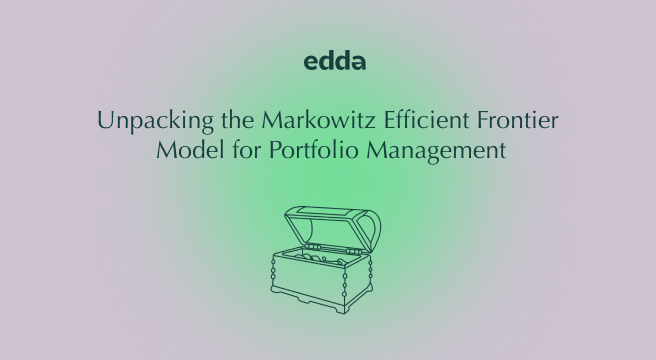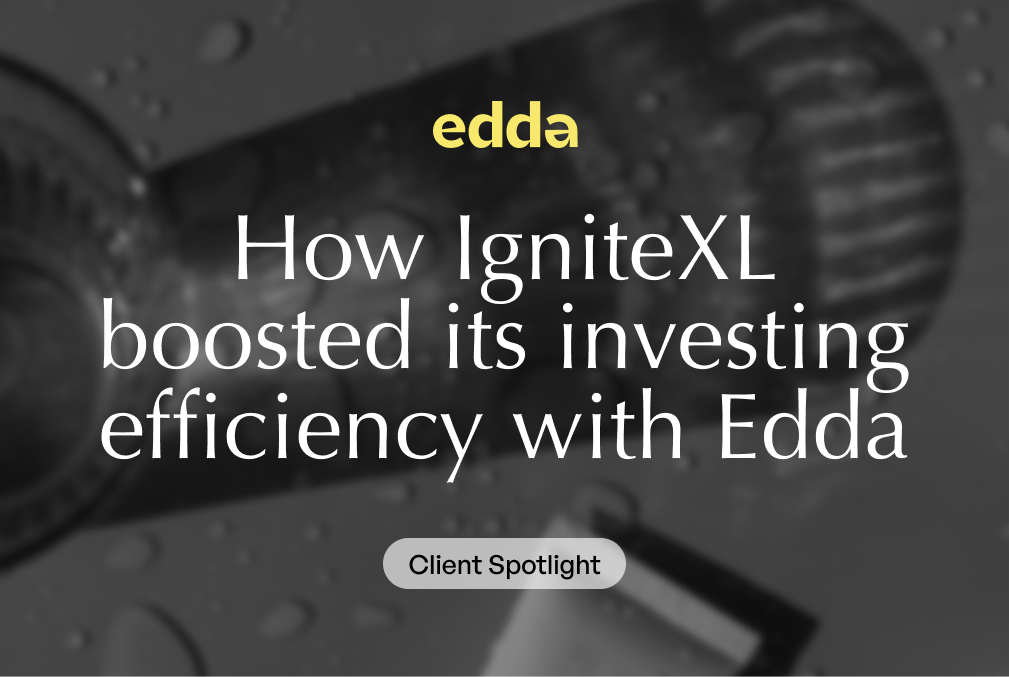Building a sturdy investment portfolio involves sifting through an array of portfolio models, all of which offer a unique blend of risk and reward opportunities. One analytical tool that aims to bring clarity to this complex decision-making process is the Efficient Frontier Model.
This article delves into the complexities and nuances of the Efficient Frontier Model, explaining its role in optimizing portfolio diversification, its limitations, and the advanced dealflow tools needed for effective implementation. Read on to equip yourself with insights that can refine your investment approach, facilitating a more precise alignment with your financial goals and risk tolerance. In addition, discover how Edda’s dealflow CRM can be a major asset to your firm.
Understanding the Efficient Frontier
Introduced by Nobel Prize winner Harry Markowitz in 1952, the Efficient Frontier serves as an indispensable element in Modern Portfolio Theory (MPT). It visually outlines the risk-return trade-off in investment portfolios, using standard deviation as the risk metric and Compound Annual Growth Rate (CAGR) as the measure for returns.
For investors, the Efficient Frontier model proposes a dual aim:
- To curate a portfolio of assets that offer high returns.
- To ensure that the collective standard deviation (risk level) of these assets is lower than the aggregate of their individual standard deviations.
The Role of Covariance
Covariance is a central pillar in the application of the Efficient Frontier model, and plays an instrumental role in portfolio optimization. The model also takes into account the covariance among various assets.
Covariance measures how two or more assets move in relation to each other over a specific period. When assets move in the same direction, they have a positive covariance; if they move inversely, the covariance is negative. A covariance near zero indicates that asset movements are largely independent of each other.
In the context of portfolio construction, the covariance among various assets helps to calculate the overall portfolio risk, which isn’t simply the sum or average of individual asset risks. When assets within a portfolio demonstrate low or negative covariance, they counterbalance each other. When one asset underperforms, the other may outperform, diluting the overall risk.
It is this ability to offset risk that adds complexity to asset selection. Investors can’t merely choose high-performing assets; they must also consider how each asset interacts with others in terms of covariance. This brings a level of subtlety to portfolio construction, necessitating a carefully crafted mix of assets to achieve a risk-return balance that aligns with the investor’s objectives.
Diversification: Benefits and Limits
The Efficient Frontier introduces a nuanced view on diversification, which is represented by its characteristic curve. This curve serves a dual purpose: On one hand, it visually conveys the merits of diversification by showing that portfolios can achieve higher returns for a given level of risk through an intelligent blend of assets.
On the other hand, the curve also manifests a saturation point, at which the incremental benefits from adding more diversity to the portfolio start to taper off. This phenomenon is known as diminishing marginal returns to risk. For instance, adding the 20th or 21st diverse asset to a portfolio may not provide as significant a reduction in risk or boost in return as adding the second or third asset did.
This aspect of saturation is critical for investors to understand because it challenges the common notion that more diversification is always better. Instead, it prompts investors to be judicious in their diversification efforts, advising them to reach a level that optimizes risk and return without unnecessary complexity or cost.
Balanced Asset Allocation According to Markowitz
Markowitz’s Efficient Frontier model emphasizes a balanced approach to portfolio creation, advocating neither an exclusively high-risk, high-return nor a low-risk, low-yield strategy. It espouses the tight linkage between risk and return, suggesting that an optimized portfolio considers a mix of equities, bonds, and commodities to align with an investor’s specific risk and return goals.
This model advocates not just simple diversification but a form of synergistic asset mixing. The sum risk of such a portfolio can be less than the risks of its individual components, thanks to smart allocation. However, diversification sees diminishing returns beyond a certain point on the Efficient Frontier curve, indicating an optimal level for risk mitigation.
Visualizing the Efficient Frontier
By plotting standard deviation against expected returns—usually denoted by Compound Annual Growth Rate (CAGR)—the graph facilitates a quick yet comprehensive understanding of how different portfolios compare. The x-axis quantifies the level of risk, allowing investors to ascertain at a glance which portfolios fall within their risk tolerance.
The curve formed on the graph presents an optimal frontier, meaning that portfolios lying on this curve offer the highest possible return for a given level of risk. This allows investors to calibrate their asset allocation with more precision, effectively assisting them in making more educated decisions about the composition of their investment portfolios.
Criticisms of the Efficient Frontier
One of the chief points of contention is the model’s assumption that asset returns are distributed in a Gaussian or ‘normal’ fashion. However, empirical observations of financial markets have frequently identified ‘tail events,’ or extreme occurrences that deviate considerably from a standard Gaussian distribution.
These events, often referred to as “black swans,” are not merely outliers; they can have a disproportionate impact on portfolio performance and challenge the model’s accuracy.
Additionally, the MPT premises several assumptions that may not align with the complexities of real-world financial behaviors and market dynamics. For instance, the theory assumes that investors operate under a paradigm of rationality and risk aversion. This overlooks the psychological factors that often drive financial decisions, such as overconfidence or herd behavior, which can significantly distort market outcomes.
Another foundational assumption is that individual investors or market participants lack the scale to influence asset prices. This simplification does not account for the influence of institutional investors, like hedge funds and mutual funds, which can wield significant power over market prices and can therefore impact the efficiency assumed by the model.
The theory also suggests that investors can borrow and lend money without constraint at a risk-free rate of interest. In practice, this is often not the case due to credit risks, borrowing limitations, and varying interest rates that depend on an individual’s or institution’s financial standing.
Practical Applications of the Efficient Frontier
In the context of VC portfolio management, the Efficient Frontier Model and its principles can be employed in several ways:
Covariance-Based Asset Selection
In the venture capital realm, the Efficient Frontier can help in selecting not just high-potential startups but also in evaluating how these startups interact with each other in terms of risk. By calculating the covariance between different investment opportunities, a VC firm can intentionally select startups that are less correlated or inversely correlated, thereby reducing the portfolio’s overall risk profile.
Optimal Exit Strategy
Using the Efficient Frontier model, venture capitalists can determine when it would be most advantageous to exit a particular investment to maintain the ideal risk-return balance in their portfolio. This involves re-evaluating the portfolio’s position against the Efficient Frontier whenever an exit opportunity arises.
Capital Allocation and Rebalancing
The position of the portfolio on the Efficient Frontier can serve as a guideline for capital allocation. For example, if the portfolio is veering too far towards high risk without a commensurate expectation of high returns, the VC may decide to re-allocate capital towards more stable, low-risk startups. Conversely, if the portfolio is too conservative, additional capital may be allocated to higher-risk, higher-return startups.
Investor Relations and Transparency
Applying the Efficient Frontier model introduces an element of scientific rigor to the portfolio management process, thereby making it easier to explain investment choices to stakeholders. This could be beneficial in retaining investor trust and in securing additional capital in subsequent fundraising efforts.
Co-investment and Syndicate Risk Management
When venture capital firms co-invest or join syndicates, the model can offer insights into how such joint ventures will impact the overall risk-return profile of the portfolio. By doing this analysis ahead of time, venture capitalists can make more informed choices about entering such arrangements.
Risk Evaluation during Due Diligence
The model can be integrated into the due diligence phase when considering a new startup for investment. Assessing where this new addition will place the portfolio on the Efficient Frontier can be pivotal for deciding whether to move forward with the deal or not.
Scenario Analysis for Future Planning
The Efficient Frontier can be used for conducting scenario analyses that examine how various changes to the portfolio could impact its risk and return profile. This can be instrumental in planning for future investment cycles, making it easier to strategize which kinds of startups to target for optimal portfolio balance.
Utilizing Edda’s Portfolio Management Tool
Implementing the Efficient Frontier model in real time requires robust computational capabilities, detailed data analysis, and sophisticated optimization algorithms. This is where Edda’s portfolio management softwares comes into play.
Edda’s venture capital portfolio management software provides a collaborative environment featuring a Shared Risk Assessment tool that allows investment professionals to collectively analyze portfolios, ensuring a more comprehensive evaluation. Additionally, the software incorporates advanced optimization algorithms tailored to implement the Markowitz Efficient Frontier Model.
Edda’s venture capital management software includes predictive analytics functionalities, which empower investment managers to anticipate market trends and fluctuations. These features facilitate proactive portfolio adjustments, enabling investors to remain aligned with the Efficient Frontier even as market conditions evolve.
While the Markowitz Efficient Frontier Model offers a compelling theoretical framework for portfolio optimization, its practical implementation requires advanced tools capable of handling the complexities involved. Edda’s venture capital CRM serves as an indispensable resource for investment managers seeking to actualize this model effectively.









